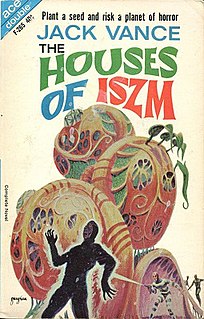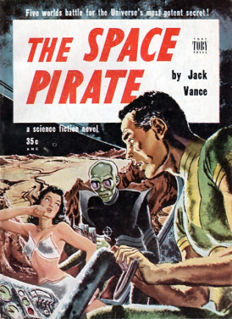
Leigh Douglass Brackett was an American science fiction writer called "the Queen of Space Opera." She was also a screenwriter known for The Big Sleep (1946), Rio Bravo (1959), and The Long Goodbye (1973). She also worked on an early draft of The Empire Strikes Back (1980), elements of which remained in the film; she died before the film went into production. She was the first woman shortlisted for the Hugo Award. In 2020, she won a Retro Hugo for her novel The Nemesis From Terra, originally published as "Shadow Over Mars".

John Holbrook Vance was an American mystery, fantasy, and science fiction writer. Though most of his work has been published under the name Jack Vance, he also wrote several mystery novels under pen names.

The Languages of Pao is a science fiction novel by American writer Jack Vance, first published in 1958, based on the Sapir–Whorf hypothesis, which asserts that a language's structure and grammar construct the perception and consciousness of its speakers. In the novel, the placid people from the planet Pao rely on other planets for technological innovations and manufactured goods and they do not resist when an invading force occupies the land and levies heavy taxes. To expel the aggressors and make the planet more independent, three new languages are introduced. A scientific language induces its speakers to innovate more; a well-ordered language encourages its speakers to be industrious; and a warlike language induces competitiveness and aggression. The new languages change the culture and Pao ousts their overlords and develops a sophisticated modern economy.
Unspiek, Baron Bodissey, is a fictional character referred to in many of the novels of speculative-fiction author Jack Vance. Within those novels he has the status of an authority, but he is sometimes referred to with amusement or scepticism. Like the 'mad poet' Navarth, he first appeared in the Demon Princes sequence but also is alluded to in a number of other unrelated stories. Unlike Navarth, the Baron never appears in person in these novels, but his monumental, many-volume work Life is frequently quoted. The lengthiest citations from it appear, with varying degrees of apparent relevance, as epigraphs to various chapters in the Demon Princes novels. Otherwise, the Baron and his work are occasionally referred to in passing or quoted by characters in the tales. Fictional reviews of Life also appear in The Killing Machine and The Face, usually dismissing it as snobbish, elitist and pretentious; one reviewer expresses a desire to thrash the Baron within an inch of his life before buying him a drink.

Planet of Adventure is a series of four science fiction novels by Jack Vance, published between 1968 and 1970. The novels relate the adventures of the scout Adam Reith, the sole survivor of an Earth ship investigating a signal from the distant planet Tschai.

Demon Princes is a series of five science fiction novels by Jack Vance, which cumulatively relate the story of an adventurer, Kirth Gersen, as he exacts his revenge on five notorious criminals, collectively known as the Demon Princes, who carried the people of his village off into slavery during his childhood. Each novel deals with his pursuit of one of the five Princes, which extends from Earth to other planets using spaceships.

Planetary romance is a subgenre of science fiction in which the bulk of the action consists of adventures on one or more exotic alien planets, characterized by distinctive physical and cultural backgrounds. Some planetary romances take place against the background of a future culture where travel between worlds by spaceship is commonplace; others, particularly the earliest examples of the genre, do not, and invoke flying carpets, astral projection, or other methods of getting between planets. In either case, it is the planetside adventures which are the focus of the story, not the mode of travel.
The Gaean Reach is a fictional region in space that is a setting for some science fiction by Jack Vance. All of his series and standalone works that are set in a universe evidently including the Gaean Reach, perhaps set inside it or outside it, have been catalogued as the Gaean Reach series or super-series.

Space Opera is a novel by the American science fiction author Jack Vance, first published in 1965.

Big Planet is a science fiction novel by American writer Jack Vance. It is the first novel sharing the same setting, an immense, but metal-poor and backward world called Big Planet.

The Houses of Iszm is a science fiction novella by American writer Jack Vance, which appeared in Startling Stories magazine in 1954. It was reissued in book form in 1964 as part of an Ace Double novel, together with Vance's Son of the Tree. The story published in Startling Stories is about 22,000 words while the version that appears in the Ace Double still less than novel length at about 30,000 words. The Houses of Iszm was re-published as a stand-alone volume in 1974 by Mayflower.
The planetary systems of stars other than the Sun and the Solar System are a staple element in many works of the science fiction genre.

William Frederick Temple was a British science fiction writer, best known for authoring the novel-turned-film Four Sided Triangle.

Maske: Thaery is a science fiction novel by American writer Jack Vance, set in his Gaean Reach milieu, which was first published as a paperback by Berkley Books, the science-fiction imprint of Putnam, in 1976. It is about a young man, Jubal Droad, from the Droad caste on the planet Maske, who has a chance encounter with an arrogant nobleman, Ramus Ymph, who almost ends up causing Jubal's death. As Jubal tries to seek a job from the powerful noble Nai the Hever, Jubal finds himself involved with Thaery's intelligence agency. Jubal's desire for revenge overlaps with the intelligence agency's interest in Ramus Ymph, leading Jubal on a planet-hopping adventure to track down his nemesis.

Cugel's Saga is a picaresque fantasy novel by American writer Jack Vance, published by Timescape in 1983, the third book in the Dying Earth series, the first volume of which appeared in 1950. The narrative of Cugel's Saga continues from the point at which it left off at the end of The Eyes of the Overworld (1966).

The Five Gold Bands is a science fiction novel by American writer Jack Vance, first published in the November 1950 issue of Startling Stories magazine. It was published in 1953 as a separate book under the title The Space Pirate, and in 1963 it was paired with Vance's Hugo Award-winning novella The Dragon Masters in the form of an Ace Double.

Son of the Tree is a science fiction novella by American writer Jack Vance. It was first published in Thrilling Wonder Stories magazine, June 1951, and in book form as half of an Ace Double in 1964 together with The Houses of Iszm. The version that appears in the Ace Double is still less than novel length at about 31,000 words, but is essentially the same as the original magazine version. Son of the Tree was re-published as a stand-alone volume in 1974 by Mayflower.

Marune: Alastor 933 (1975) is a science fiction novel by Jack Vance, the second of three books set in the Alastor Cluster, ‘a whorl of thirty thousand stars in an irregular volume twenty to thirty light-years in diameter’. Three thousand of the star systems are inhabited by five trillion humans, ruled by the mostly hands-off, laissez-faire Connatic, who occasionally, in the manner of Harun al-Rashid of The Thousand and One Nights, goes among his people in disguise. The novel was preceded by Trullion: Alastor 2262 (1973) and followed by Wyst: Alastor 1716 (1978).















